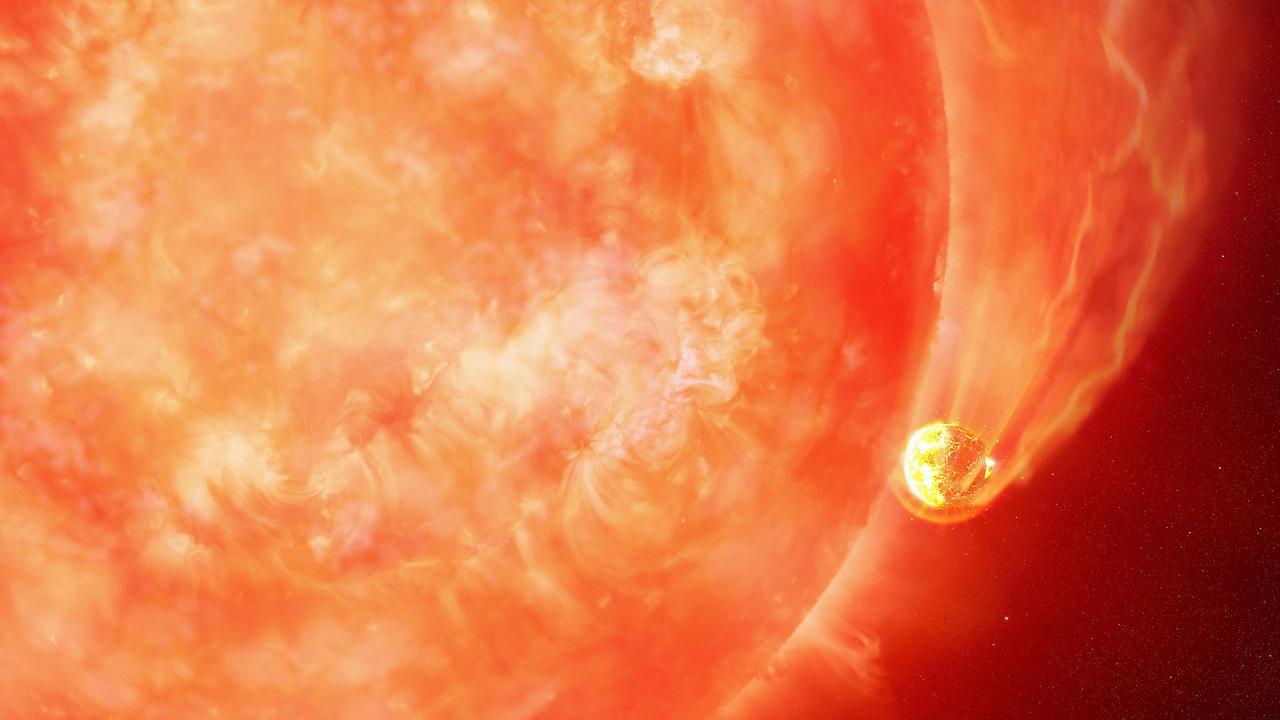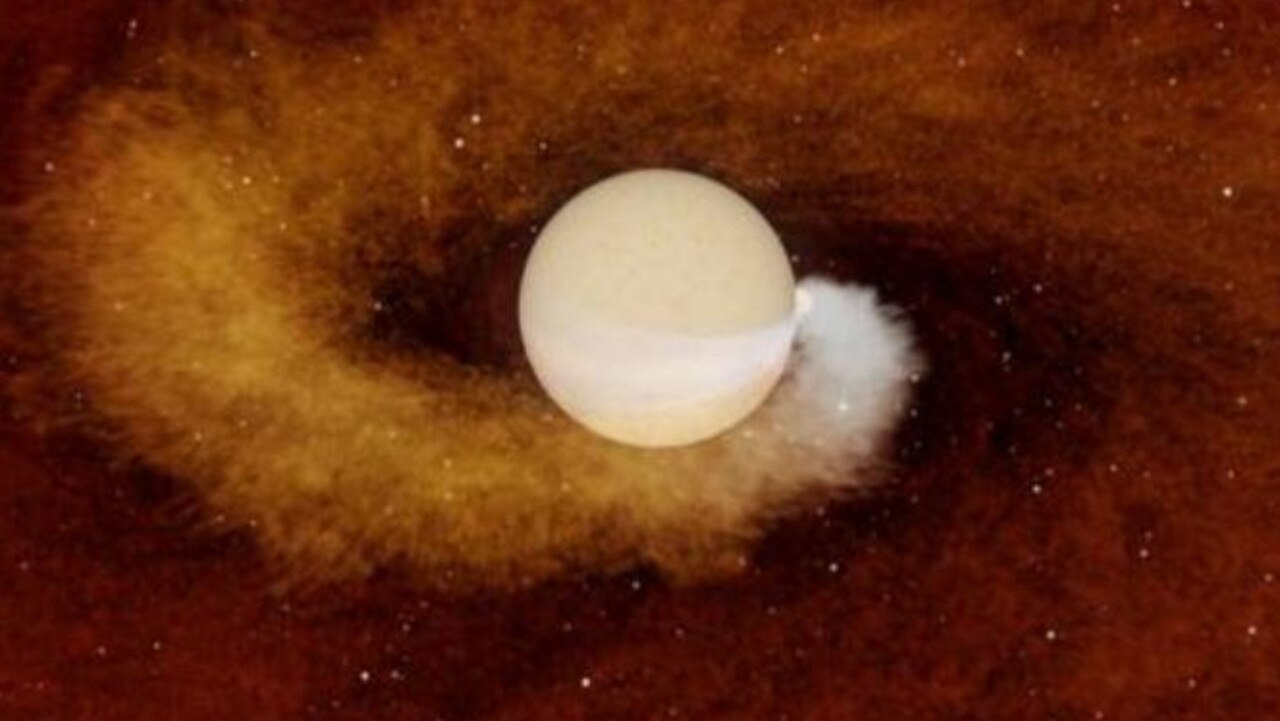Scientists witness planet being swallowed by host star for the first time
Scientists have made an incredible discovery by observing, for the first time, a planet being swallowed by its host star. The event which took place around 12,000 light years from Earth.

READING LEVEL: RED
Scientists have observed a planet being swallowed by its host star* for the first time.
They believe this could be a preview of what could one day happen to Earth – but don’t worry, that won’t be for about another five billion years.
The US astronomers said that when the sun finally does engulf* Earth, it will cause only a “tiny perturbation*” compared to the cosmic explosion* they just witnessed.
Most planets are believed to meet their end when their host star runs out of energy, turning into a red giant* that massively expands, devouring* anything unlucky enough to be in its path.
Astronomers had previously seen the before-and-after effects of this process, but had never caught a planet in the act of being consumed.
Lead researcher Kishalay De, from the Massachusetts Institute of Technology (MIT) in the US, said the accidental discovery unfolded like a “detective story”.
“It all started about three years ago when I was looking at data from the Zwicky Transient Facility survey, which takes images of the sky every night,” Dr De said.
He stumbled across a star that had suddenly increased in brightness by more than 100 times over a 10-day period.

The star is in the Milky Way galaxy, around 12,000 light years from Earth near the Aquila constellation, which resembles an eagle.
Dr De had been searching for binary star systems*, in which the larger star takes bites out of its companion, creating incredibly bright explosions called outbursts*.
But data showed that this outburst was surrounded by cold gas, suggesting it was not a binary star system.
And NASA’s infra-red space telescope NEOWISE showed that dust had started to shoot out of the area months before the outburst.
More puzzling still was that the outburst produced around 1000 times less energy than previously observed mergers between stars.
The team of researchers from MIT, Harvard University and California Institute of Technology (Caltech) established that the swallowed planet was a gas giant* with a similar mass* to Jupiter, but was so close to its star that it completed an orbit* in just one day.
The star, which is quite similar to our sun, engulfed the planet over a period of about 100 days, starting off by nibbling at its edges, which ejected* dust.
Their study, published in the journal Nature, noted the bright explosion occurred in the final 10 days as the planet was totally destroyed when it plunged inside the star.
Miguel Montarges, an astronomer at the Paris Observatory who was not involved in the research, noted that the star was thousands of degrees hotter than the planet.
“It’s like putting an ice cube into a boiling pot,” he said.
Co-author of the study Morgan MacLeod, from Harvard University, said that most of the thousands of planets discovered outside the Solar System so far “will eventually suffer this fate”.

And in comparison, Earth would most likely end not with a bang but a whimper. When the sun expanded past Mercury, Venus and Earth in an estimated five billion years, they would make “less dramatic disturbances” because rocky planets* were so much smaller than gas giants, Dr MacLeod said.
“In fact, they will be really minor perturbations to the power output* of the sun,” he said.
But Dr MacLeod said that even before it got swallowed, Earth would already be “quite inhospitable*,” because the dying sun would have evaporated* all the planet’s water.
Now that astronomers know what to look for, they hope they will soon be able to watch many more planets be consumed by their stars.
In the Milky Way alone, a planet could be engulfed once a year, Dr De said.
GLOSSARY
- host star: a star around which a planet orbits
- engulf: to swallow or surround completely
- perturbation: a small change or disturbance in something
- cosmic explosion: an explosion in space that produces a lot of energy
- red giant: a very large star that is near the end of its life and has expanded to a large size
- devouring: the action of eating something hungrily or quickly
- binary star system: a system of two stars that orbit around a common centre of mass
- outburst: a sudden and violent release of energy
- gas giant: a large planet composed mostly of gases
- orbit: the path that a planet follows as it revolves around a star
- mass: the amount of matter in an object
- ejected: thrown out or expelled
- rocky planets: planets that are primarily made of rocks or metals rather than gases
- power output: the amount of energy produced by a star
- inhospitable: not suitable or comfortable for living things
- evaporated: to change from a liquid to a gas
EXTRA READING
Look out for rare planetary show
Jupiter's record-breaking 92 moons
Webb telescope snaps stunning Jupiter
QUICK QUIZ
- What did scientists observe for the first time?
- When do scientists predict that the Earth will be engulfed by the sun?
- What is the most common way that planets meet their end?
- How did lead researcher Kishalay De discover the planet being consumed?
- What is the name of the survey that takes images of the sky every night and helped Dr. De make the discovery?
LISTEN TO THIS STORY
CLASSROOM ACTIVITIES
1. What Would They Say?
Create a diagram. The purpose of your diagram is to show how and why planets are swallowed by stars.
Time: allow 30 minutes to complete this activity.
Curriculum Links: English, Science.
2. Extension
What would you say to someone who was scared about the earth being swallowed by the sun? Write down facts from the story that will help them to stop feeling worried!
Time: allow 10 minutes to complete this activity.
Curriculum Links: English, Science
VCOP ACTIVITY
Planet or Star?
Can you listen for key words and identify whether the statement refers to a planet or a star in the article.
Instructions:
- Divide the children into two teams.
- One team will be assigned to represent planets, and the other team will represent stars.
- The teacher will read a statement from the article, and the teams will have to discuss and decide if the statement is about a planet or a star.
- The teams will take turns guessing their answer.
- The teacher will reveal the correct answer, and the team with the correct answer will get a point.
- The game continues until all the statements have been read, and the team with the most points at the end of the game wins.
Extension:
Have students make their own version of the game for another group. Can they come up with a new goal other than planet or star?
Example statements for teacher to read:
They believe this could be a preview of what could one day happen to Earth.
Answer: Planet
Most planets are believed to meet their end when their host star runs out of energy.
Answer: Planet
US astronomers said that when the sun finally does engulf Earth, it will cause only a “tiny perturbation” compared to the cosmic explosion they just witnessed.
Answer: Planet
Lead researcher Kishalay De stumbled across a star that had suddenly increased in brightness by more than 100 times over a 10-day period.
Answer: Star
The outburst produced around 1000 times less energy than previously observed mergers between stars.
Answer: Star
The team of researchers established that the swallowed planet was a gas giant with a similar mass to Jupiter.
Answer: Planet
The star, which is quite similar to our sun, engulfed the planet over a period of about 100 days.
Answer: Planet
Earth would most likely end not with a bang but a whimper.
Answer: Planet
When the sun expanded past Mercury, Venus and Earth in an estimated five billion years, they would make “less dramatic disturbances” because rocky planets were so much smaller than gas giants.
Answer: Planet
Now that astronomers know what to look for, they hope they will soon be able to watch many more planets be consumed by their stars.
Answer: Planet

